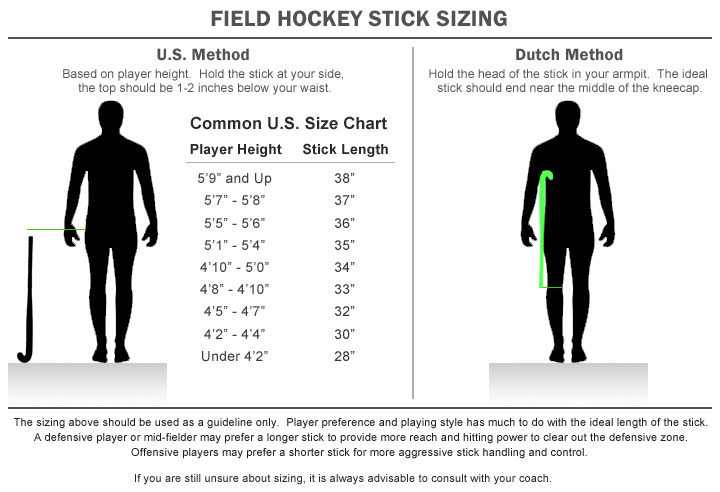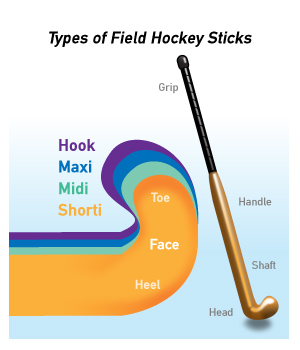Field Hockey Stick Buyers Guide
- Is the most expensive field hockey stick the best for me?
- What size stick is right for me?
- What are the parts of a field hockey stick?
- Which toe design is right for my game?
- Which stick bow is right for my game?
- How does a stick's material affect its performance?
- How does a stick's weight affect its performance?
Since just before the 19th century, modern field hockey had evolved in England and today, it has developed into a universal sport. Other than your own expertise, your field hockey stick is your most valuable asset on the field. It not only compliments your skills, but it also contributes to your performance by allowing you to execute outstandingly come game time. Sports Unlimited recognizes just how important finding the right field hockey gear is. With brands such as Cranbarry, TK, Grays, Brine, STX and more, we?ve got you covered! In order to narrow down some of your options, you should consider the following features before making a purchase:
- Level of Play
- Position
- Size
- Toe Design
- Bow
- Composition
- Weight
Is the most expensive field hockey stick the best one for me?
Field hockey sticks can, admittedly, get a bit pricey. But the key thing to know is that the most expensive stick is not necessarily the best field hockey stick for you or your child! If you or your little one is just starting out in field hockey, and still learning the game, you may be short changing them by buying the most expensive stick.
That's because, typically, the more expensive hockey sticks have a high carbon content, making them pretty powerful, but also really stiff. This stiffness and power makes it a lot harder to stop the ball, control it, and maneuver it on the field, making that expensive stick pretty difficult to use for newer players.
More affordable hockey sticks are usually constructed with either wood, fiberglass, or aramid, materials that deliver a lightweight, less rigid, and also less powerful stick. These sticks make it easier to stop the ball at the head, and control the ball across the field. In this way, those sticks are much more forgiving for younger and developing players.
At the end of the day, if you or your child is just starting out in field hockey, look for a more affordable, more forgiving field hockey stick. Once they start playing, they will begin to understand which stick works best for them, and they can move on to more expensive, more advanced level sticks.
What size stick is right for me?
Field hockey sticks come in a wide range of lengths, to fit any size or age player on the field. Ranging from about 28" to 38" long, field hockey stick length can drastically affect your game and your comfort on the field.
For instance, a stick that is too long will be clunky and difficult to maneuver, and may limit your agility on the field. On the other hand, a stick that's too short may not let you get enough power behind your shots and passes, limiting your range on the field.
There are two standard methods for finding the appropriate stick length for your body; the U.S. Method, and the Dutch Method, found below:

It's important to keep in mind that, generally, the suggested length will vary slightly by manufacturer, but all methods will produce similar results. Also, if you're stuck between two lengths (for example, 35" or 36"), you should consider your child's position:
- On defense, a longer stick is useful to provide a longer reach and to allow the player to drive the ball further.
- On offense, a shorter stick improves a player's stick handling skills
If you're still unsure, consult your child's coach for further clarification.
What are the parts of a field hockey stick?

Shaft / Handle / Grip - The top end of the field hockey stick typically features a high-tack grip or tape to let you easily swing and maneuver the stick.
Head - The end of the field hockey stick that makes contact with the field and the ball. The head is flat on one side (face) and rounded on the other, to give you a wide surface area to shoot, stop, and pass the ball.
Heel - The bend of the head where it joins the toe of the stick.
Toe - Where the head upturns, creating a striking area for the ball. Toes come in a variety of styles and sizes offering different benefits to players of varying skill levels and positions.
Scoop - The 2mm groove in the head of the stick, the scoop aids in ball control, cradling, and other maneuvers.
Bow - The slight bend in the stick from handle to head. The bow cannot exceed 25mm.
Which toe design is right for my game?

A stick's toe is curved and designed to complement that way a player strikes the ball and handles the stick. Smaller toes provide maximum maneuverability and agility, while limiting striking surface and power, while larger toes provide plenty of striking and receiving area for the ball, while reducing the stick's overall maneuverability.
Typically, field hockey stick toes come in four shapes:
Shorti - A very common toe length, great for quickly turning the stick over the ball. Generally used by offensive players for its balance, maneuverability, and control.
Midi - By far the most widely used toe shape for beginners and (as the name implies) midfielders. Slightly longer than Shorti toes, Midi toes allow for a larger hitting surface without reducing agility, making flicking, receiving, and reverse play easier and more comfortable, especially for newer players.
Maxi - The largest standard toe, Maxi toes are preferred by defensive players for their wide striking and receiving surface, along with solid power.
Hook - A J-shaped toe, the Hook is a two-piece head that allows for extra surface area, designed to increase ball control for better drag-flicks and reverse stick play.
Which stick bow is right for my game?
Almost every advanced composite stick you'll see has a bow in the shaft, meaning the stick bends slightly from the handle to the toe. Most sticks feature a 20mm bow, but others can range up to 25mm. The bow can also shift from stick to stick, altering the when the center of the stick falls, and changing the way it plays.
For instance, a standard bow benefits every area of the game equally, while a more dramatic bow creates a more dramatic head angle, to assist in dynamic controls and lifts. Bow choice should depend on preference, age, and skill level.
Understand the three types of bows to get a better idea of which stick is right for you:

Regular Bow
Typically measuring 20 - 25mm, with a regular bow, the highest point of the bend falls in the middle section of the stick. This makes for well-rounded performance, assisting in every aspect of the game from ball control to advanced maneuvers.

Control Bow
With a control, or mega bow, the center of the bend moves closer to the to toe, to provide extra power when lifting the ball and drag flicking. Meant for more advanced players, this bow allows for dynamic control and competitive level maneuvers.

Late Bow
Measuring 25mm, the late bow, or low bow, places the bend at the furthest end of the stick, right before the head. The late bow is meant for elite level players, and delivers extra assistance when controlling the ball, lifting the ball, performing aerials, and drag flicking.
How does a stick's material affect its performance?
Field hockey sticks were once all made out of wood, but those days are no longer. While you can still find solid wood sticks out there, most modern and higher-level sticks are composite, or made of a combination of materials. Varying levels of composites alter the performance, weight, power, and stiffness of a stick, as well as its price. So to make sure you're getting the right stick for your skill level and needs, it's important to know what each material offers, and what it is designed for:
Carbon:
- Designed for stiffness and rigidity, greater carbon content in a stick gives it harder hits and more power.
- Carbon content can run as high as 90% of a stick's make-up, although even a 50% carbon stick is still going to give you elite-level power.
- Carbon-heavy sticks are inherently less-forgiving than other materials, and require greater skill to maneuver and wield. They also tend to be a little heavier than other sticks.
- Sticks with more carbon content are recommended for advanced and elite-level players.
Fiberglass:
- Found in almost every composite field hockey stick on the market, in some level, fiberglass adds durability, power, and feel to a stick.
- Similar in nature to carbon, but more economical, fiberglass delivers the feel of a high-end, high-performance stick without the high price tag.
- Fiberglass sticks also tend to be lighter, and less rigid than carbon-heavy sticks, making them more forgiving and better designed for young, new, or developing players.
Aramid:
- Meant to dampen and absorb vibrations sent through the stick when striking and receiving balls, aramid is a great balancing material found in many field hockey sticks.
Wood:
- Modern wooden sticks still exist, although most are wrapped in fiberglass to add strength and power.
- Known for their natural feel and solid control, as well as their lower price tag, modern wooden sticks are great for young and developing players.
Which toe design is right for my game?
Although, these days, most field hockey sticks are fairly light and easy to maneuver, there are still variations in weight that make a stick more appropriate for a player or position. Typically, manufacturers provide approximate weights for the 35" or 36" versions of their sticks, but to find the weight of your size stick, simply add or subtract about 10 grams for every inch. Once you have the weight of the stick, assess which position the stick is designed for:
- 19 - 20 ounces (approx. 540 - 565 grams) - Designed for forwards, a lightweight stick doesn't interfere with, or hold back rapid stick work.
- 21 ounces (approx. 595 grams) - Designed for midfielders, a mid-weight stick benefits both defensive and offensive maneuvers.
- 22 - 24 ounces (approx. 620 - 680 grams) - Designed for backs, the heavier sticks put serious power and distance behind your shots, making them great for clearing the ball.
